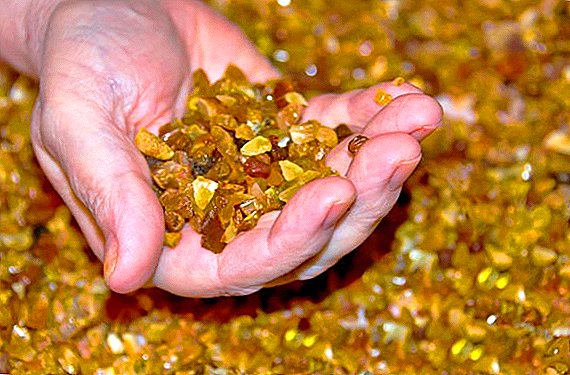 If there is such a furry creature like a rabbit at home, you need to not only skillfully care for him, but also learn in time to pay attention to changes in the state of the animal. Quickly identified health problems and a visit to the vet can greatly affect the state of fluffy.
If there is such a furry creature like a rabbit at home, you need to not only skillfully care for him, but also learn in time to pay attention to changes in the state of the animal. Quickly identified health problems and a visit to the vet can greatly affect the state of fluffy.
The first sign by which problems can be identified is temperature. What it should be, how to measure it and what to do if there are problems - you will learn about all this below.
The temperature of the body of a rabbit
On the body temperature of an animal is influenced by many factors: from conditions of detention and even to the time of year. In addition, we must always remember that this figure in rabbits may change from time to time. When changing climate, conditions of detention and the time of year it is necessary to monitor the condition of the animals.
Important! If there are any changes in the behavior of the animal, it refuses to eat, behaves restlessly or, on the contrary, moves a little and is constantly lying, slumped or sneezing, then this may indicate problems or illness. You should not immediately panic, but the temperature must be measured. If it is too high or too low - need to contact the vet.
Summer
Indicators of body temperature in adults may vary at elevations of + 38-40 ° C. In the summer, in hot conditions of maintenance, indicators can increase to +41 ° С. The norm in the summer of pets is the mark of + 38.5-39.5 ° C. If there is an increase to +42.5 ° С and more, this indicates problems.
Newborn rabbits differ from more adult individuals not only in appearance, but also in temperature marks, they have a higher one and keep within + 40-41 ° С (decrease to +35 ° С is considered critical, as well as increase to +42 ° С and more). In young animals of two to three months, the indicators are approximately at the same level, the marks of +32 and +42 ° C are considered critical - they mean overcooling or overheating of a pet.  In the summer it is very important to monitor not only the temperature of the body, but also the external environment. The optimum content will be + 15-17 ° C. With an increase in the temperature of the external environment, it is possible to observe changes in the state of the animal - if it rises to + 23-25 ° C, then the rabbit begins to breathe rapidly, and at +30 ° C he begins to breath. On especially warm days, it is necessary to give more water to the animals and leave the cage in the shade so that the pets do not get a heat stroke (it is also reflected in the body temperature marks).
In the summer it is very important to monitor not only the temperature of the body, but also the external environment. The optimum content will be + 15-17 ° C. With an increase in the temperature of the external environment, it is possible to observe changes in the state of the animal - if it rises to + 23-25 ° C, then the rabbit begins to breathe rapidly, and at +30 ° C he begins to breath. On especially warm days, it is necessary to give more water to the animals and leave the cage in the shade so that the pets do not get a heat stroke (it is also reflected in the body temperature marks).
Find out how many years rabbits live in different breeds.
In winter
The indicator for an adult individual and young stock in the winter period can decrease to +37 ° С in the event that animals are kept outside, this is quite a normal phenomenon, which indicates adaptability to external conditions. Critical are +30 ° C and below.In this case it is worth to consult a doctor immediately.  If the air temperature drops, the rabbits will compensate for this by basking in the sun. Their body reacts rather calmly to lowering the indices, if before that preparatory work had been carried out (the rabbits got used gradually to cooling the air outside). Animals can easily tolerate frosts of up to -20 ° C with occasional walks, which are still undesirable due to dramatic changes in indicators on the street and in the house. If rabbits live in cages in the winter, but they have a warm undercoat that protects them from frost.
If the air temperature drops, the rabbits will compensate for this by basking in the sun. Their body reacts rather calmly to lowering the indices, if before that preparatory work had been carried out (the rabbits got used gradually to cooling the air outside). Animals can easily tolerate frosts of up to -20 ° C with occasional walks, which are still undesirable due to dramatic changes in indicators on the street and in the house. If rabbits live in cages in the winter, but they have a warm undercoat that protects them from frost.
Did you know? There is a legend among North American Indians that many centuries ago, when the world was young, rabbits stole fire from "fiery inhabitants" and passed it on to people, saving them from cold and darkness.
How to measure rabbit temperature
You can measure the temperature and a simple thermometer, which is used for people, with both mercury and digital. The second one is better to use in this case, as it allows to get the result in just a minute or two, while the mercury thermometer needs to be held for 6-7 minutes, while keeping the animal. In addition, a simple thermometer is usually made of glass, so it can harm the animal (the rabbit may begin to move or be nervous, increasing the risk of injury from shrapnel). Digital is made of plastic, so it is more practical, moreover, it is often more mobile, because it can be bent a little.  Before starting the process, the thermometer must be disinfected, and then smeared with petroleum jelly or a special gel, as it will be inserted into the anus. Sometimes a baby cream is also used, since it also softens the input of the thermometer well. The animal is placed on a horizontal surface and slightly stretched, the paws are fixed.
Before starting the process, the thermometer must be disinfected, and then smeared with petroleum jelly or a special gel, as it will be inserted into the anus. Sometimes a baby cream is also used, since it also softens the input of the thermometer well. The animal is placed on a horizontal surface and slightly stretched, the paws are fixed.
The thermometer is gently inserted into the anus to a depth of about 1-1.5 cm. The indicators are removed, while the thermometer should characteristicly squeak, after which it is carefully removed. If the rabbit behaves very restlessly, twitches and does not allow to take readings, then it is better to let it go and measure the temperature a little later when it calms down.
Important! Measurement is best done together. This allows one person to hold the animal, calming it in the process, and the second to engage in measurement.If you perform the procedure together - take the rabbit on your knees and hold it with your hands or place it under your armpit. The helper should be located opposite and hold the pet's hind legs. After that, you need to gently introduce a thermometer, during which the second person holds the pet so that it does not twitch and escape.
Video: How to measure the temperature in animals?
What if the temperature
To do something, relying only on one testimony of a thermometer, is not worth it. They may be slightly elevated as a result of stress or the procedure itself. Minor changes are quite normal, but if the indicators last longer, the deviations are too large, the animal behaves restlessly, it has obvious signs of illness, or you notice other symptoms, you need to move to more serious measures.
Read about common diseases of rabbits that are dangerous to humans.
Above normal
Most often, a small fever may indicate stress or overheating. If this is the first, then it will pass by itself, and the temperature will not change very much. Overheating must be eliminated, because the animal does not have sweat glands due to the anatomical structure, and thermoregulation occurs due to the ears and the respiratory system.
Here's what to do if a rabbit has a fever:
- Wipe your pet's ears with a damp and cool cloth. It can be wetted in ordinary water. Thanks to this simple action, the ears are cooled and the overall body temperature also decreases. This advice can be used even when the weather is hot - rub your ears for 5-10 minutes a day and the rabbit will feel much better, it will be easier for him to tolerate the heat.
- Air the room regularly. Let's take a lot of water in the summer. If possible, use cooling systems (in no case do not point the fans at the pet - it can seriously get sick).
- If there is a constant increase of more than +41 ° C, the animal is depressed, moves a little, does not eat, does not breathe (shortness of breath or wheezing), then you should show it to the doctor. Such symptoms may indicate pneumonia.
- In the case when the pet sneezes and the temperature is slightly elevated, it is necessary to clean the cage at home. A similar problem can be caused by poor straw with dust or simply dirt. Check bedding and straw, they can cause allergies. This symptom will disappear very quickly if the problem is resolved.
- When the rabbit sneezes, he has a constant temperature rise - it is better to consult a doctor, as he can listen to the lungs of the animal with a stethoscope for inflammation. In case of discharge from the nose and eyes, this can be a symptom of a cold, which also requires treatment by a veterinarian.


Did you know? In Mexico, there is a tradition before drinking alcoholic beverages to splash a little on the floor - This is a victim of rabbits. This is due to one legend. Once upon a time a woman named Mayagual, who, walking near the field, noticed a rabbit there - He ate agaves and began to run around the field very actively, in a completely incomprehensible state. So she discovered the alcoholic properties of agave and began to prepare drugs from it. The gods rewarded her for this, making her a goddess. After that, she gave birth to 400 rabbits, which became the patrons of intoxication among the Aztecs.
Below normal
A decrease in normal values may indicate very serious health problems. Such indicators require urgent intervention by specialists. A decrease in body temperature may indicate shock or late stages of complex infections.
If you can not immediately see a doctor, then you need to take measures to raise the temperature at home:
- You can immerse the animal under a warm stream of water. It is impossible to wet the head. After that, the body must be dried and wound in a cloth, towel or flannel and placed in heat.
- Use a special infrared lamp if it is (it can be purchased at any veterinary or hardware store, as it is used in poultry and animal husbandry). Optimally turn on the lamp at +40 ° C.
- You can warm your pet with warmth. It helps especially well if it is still a cub, as it not only warms, but also calms down next to the owner.
- Use hot water bottles or hot water bottles by placing them under the belly or near the animal. Be sure to wrap hot bottles in towels so as not to burn the fluff.
- Wrap the animal in towels heated with an iron or a battery.

Familiarize yourself with the causes and methods of treating eye and ear diseases in rabbits, and also find out from which diseases it is necessary to vaccinate eared animals.
It is advisable to raise the body temperature to at least +38 ° C. As soon as the performance rises - immediately contact your doctor. The temperature of the rabbit is a variable indicator. These fluffy creatures are quite gentle and react sharply to any changes, so anything can affect them: stress, poor conditions, and many other factors. Usually, small fluctuations in temperature are normal, but if the problem persists and other symptoms accompany it, you should always consult a doctor. Such a step will help to avoid serious problems with the pet's health.












